A scaffolding for nature to live and grow on
Rewilding Arts Prize winner Justin Tyler Tate's post-Anthropocene architecture aims to serve nature while inspiring empathy for the non-human world.


Consider the birdhouse: a simple wooden box held together by nails or glue, sometimes with a peaked roof and a coat of paint, maybe an affectatious window carved into one side. Nothing like it exists in nature. It’s the conspicuous product of human hands, designed solely to shelter songbirds and their chicks from predation and weather. If the human builder benefits at all, it is intangibly, by way of songs, sightings and a dose of empathy. Birdhouses, then, are a very peculiar kindness.
Justin Tyler Tate has taken this kindness to new extremes in what he calls “post-Anthropocene architecture” – structures built for the benefit of non-human species, but typically on a much grander scale than what you’d find in a backyard. It’s a concept he himself invented, and is still in the process of refining.
“Post-Anthropocene architecture is a scaffolding for nature to live and grow on,” says Tate, one of six winners of the Rewilding Arts Prize presented by the David Suzuki Foundation and Rewilding Magazine. “Birdhouses and bat boxes can be viewed as the most simplistic form, as their primary function is as habitat for other species and they only provide secondary benefits to humans. But they are quite small.”
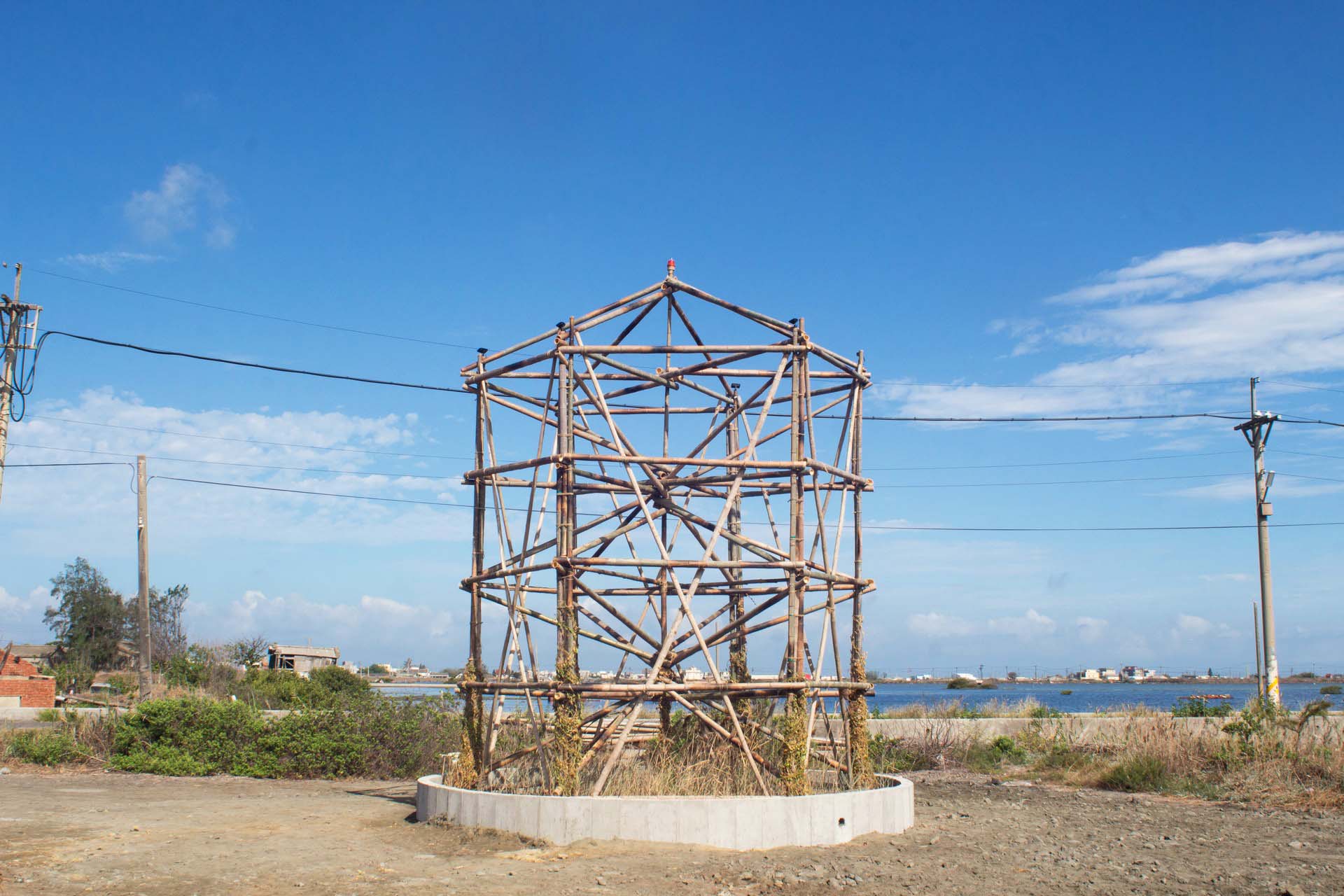
In contrast, Tate’s work is difficult to miss. One of his most recent projects, built in 2021 in the Chenglong Wetlands of Taiwan, is an interlocking lattice of bamboo poles, forming a compact frame on which migratory birds can easily rest and nest: maximum perch in a minimum of space. At its base is a circular garden of native plants ideal for food and nest construction, continuously fertilized by the droppings of visiting birds. Much to Tate’s surprise, this structure (christened Avialae) received its first visitors even before he finished building it. They were wild dogs, keen to escape the heat of a Taiwanese spring beneath the bamboo.
Another recent work was Mushhouse, its name suggesting the intended occupant. Over a frame of rot-resistant cedar boards (one central beam and several struts), Tate built an open, gazebo-like layer of deadwood, using chiefly maple and oak, each log inoculated with mycelia. This deadwood was intended to blossom with mushrooms for human and animal consumption in 2020, as brilliant and brief as a roman candle, but the winds of Michigan keep Mushhouse drier than expected, and the sporous explosion Tate envisioned has become a slow, fruitful burn.
“I like to imagine that deer are attracted to the structure to eat the shiitake, lion’s mane and pearl, king and golden oyster mushrooms when they emerge from the wood,” he says.
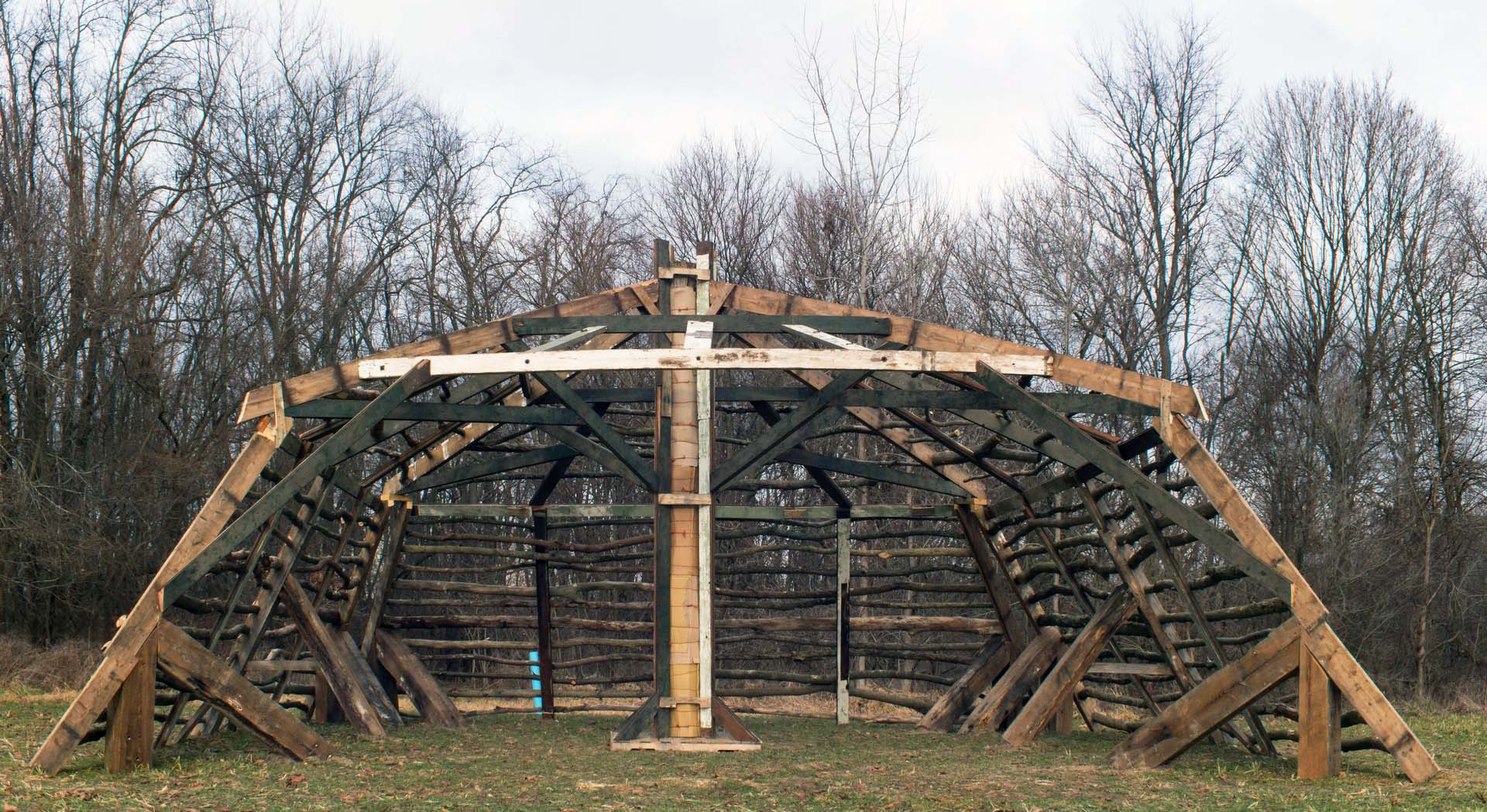
To call Tate any one thing would be reductive. On his resume are architecture, carpentry, joinery, botany, cooking, chemistry, electronics, new media and five books covering several of these subjects. It is perhaps fairest to call him an artist, his architecture being one expressive medium of many, often blended with the others.
He is also nomadic. Born in Canada, raised in Florida and educated by the Nova Scotia College of Art and Design, Tate has been on the move more or less constantly since his mid 20s. He’s also been a formal resident of Estonia, Finland and Taiwan, and has lived for three months or more in Lithuania, Latvia, Italy, Hungary, Ukraine, Norway, Japan, Australia, Korea and England.
“Since I was a kid,” he says, “I’ve always just called wherever I’ll be sleeping home.”
Tate's architecture (post-Anthropocene and otherwise) is typically undertaken while an artist-in-residence with one institution or another, such as with the Chenglong Village when building Avialae, and the Prairie Ronde Artist Residency when building Mushhouse. But sometimes, Tate works entirely on his own.
In 2010, having arrived in Australia with no tools or materials, he found his way to the eastern fringe of the Great Victoria Desert, established himself outside the mining town of Coober Pedy, and built a lemonade stand with whatever he could find on site. The idea was to incorporate the landscape itself into the work, both in terms of raw material and setting. And when you’re in the desert, he says, lemonade justifies itself. He built a second stand in 2011, this time in Lithuania – significantly less hot, but, for his purposes, no less evocative.
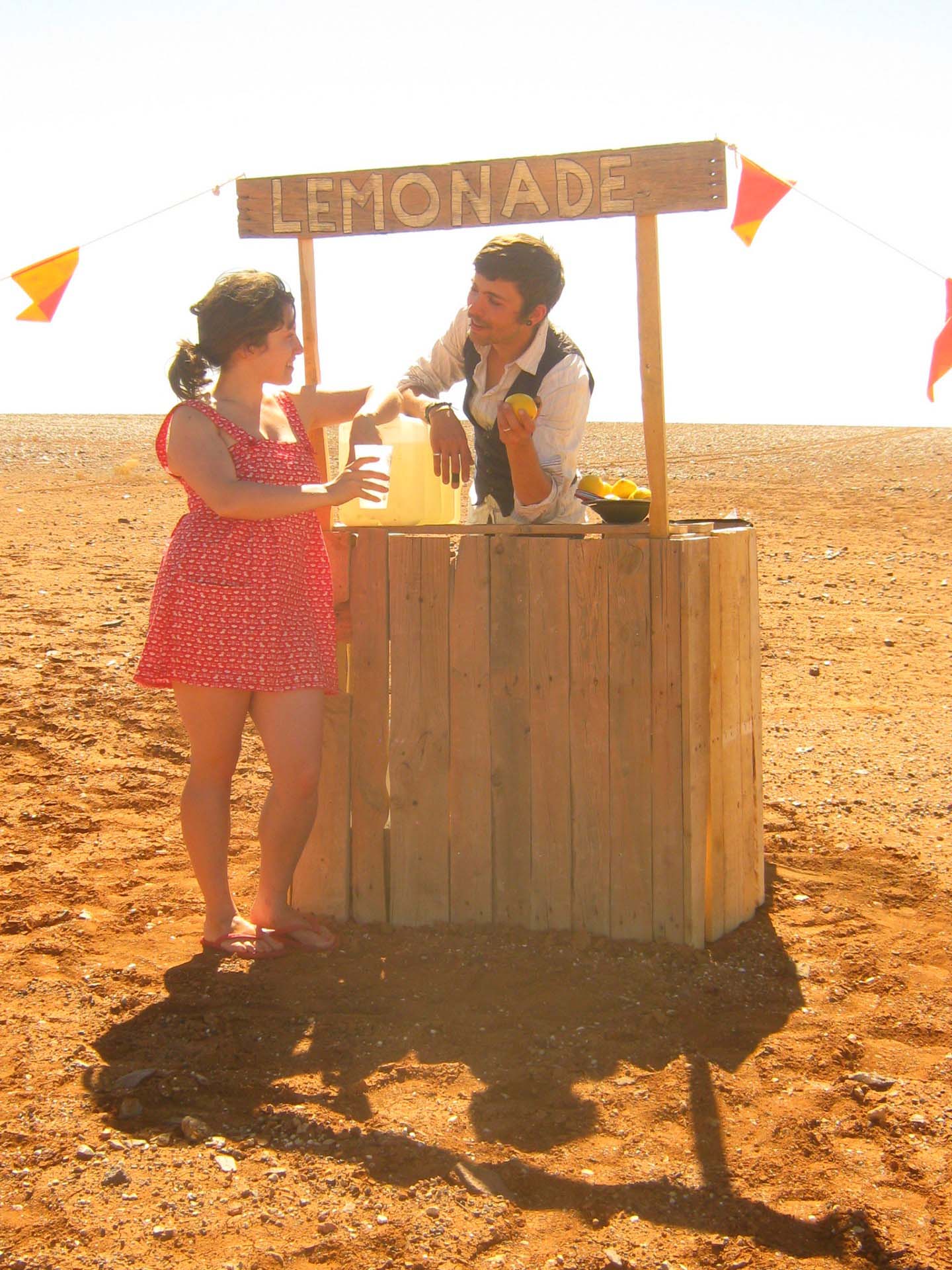
Tate began toying with post-Anthropocene architecture in 2018, when he built his risen earth structure Untitled in Vistabella del Maestrazgo, Spain. In 2022, he had the opportunity to refine his ideas while an artist-in-residence at the Nordic Artists’ Centre Dale in Sunnfjord, Norway, exploring what post-Anthropocene architecture should and shouldn’t be, through a rash of experimentation.
For three months, he forsook the luxuriously equipped studios of the Dale and lugged his tools deep into the Norwegian woods, searching for inspiring sites with sufficient material. Unlike his previous forays, the structures he built were entirely unplanned, each of them an improvised “sketch” on the landscape. And since he could handle only so many return trips over Scandinavian mountains, each was finished in a single visit, even if that meant skipping meals. This was, on occasion, a challenge.
“I was spending a lot of time climbing up and down mountains every day, carrying a backpack full of tools and one time carrying some logs of apple wood,” he says. “I had to eat a lot to compensate for all of the calories I was burning. I end up eating three times what most people do [when I work].”
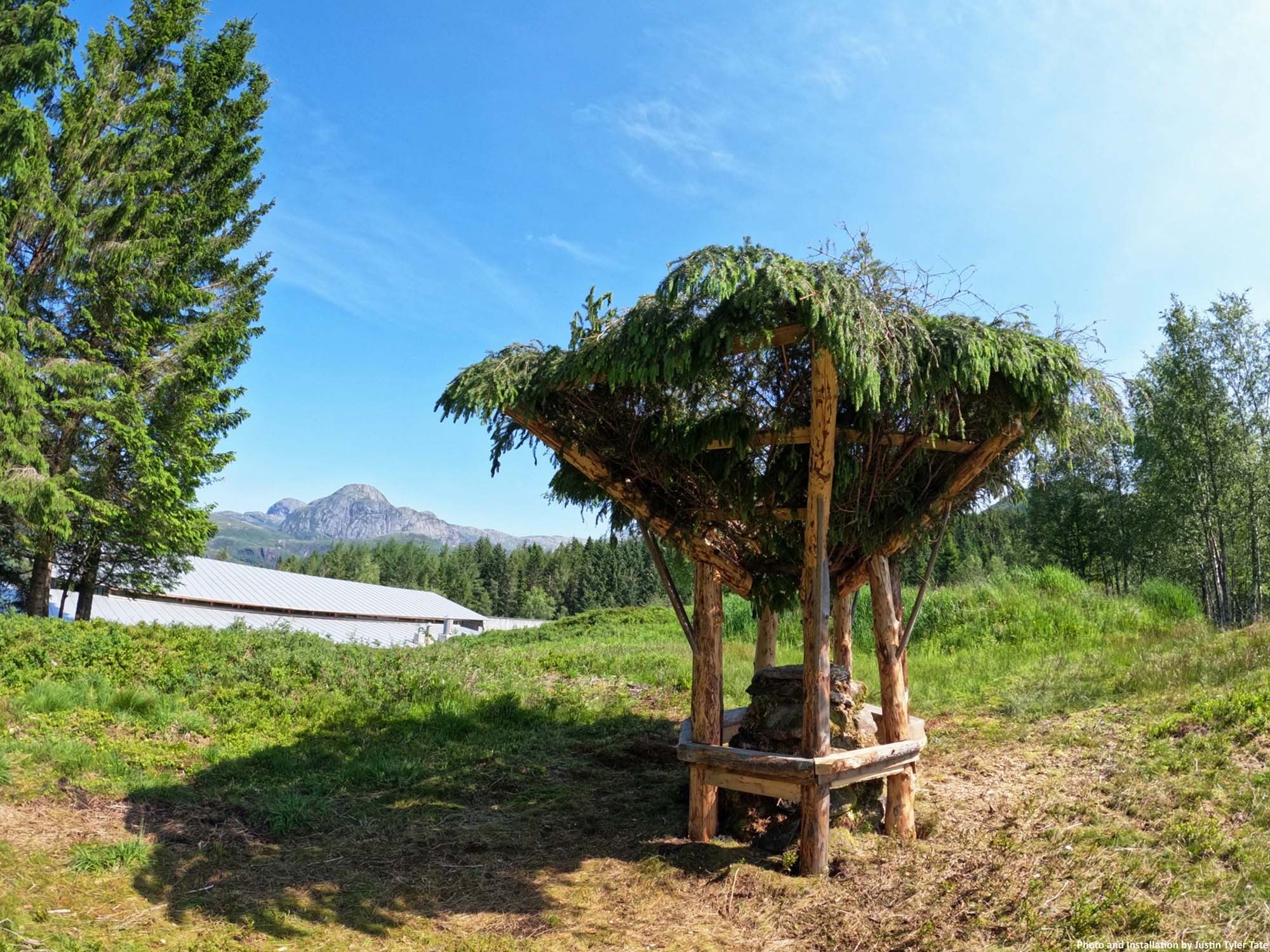
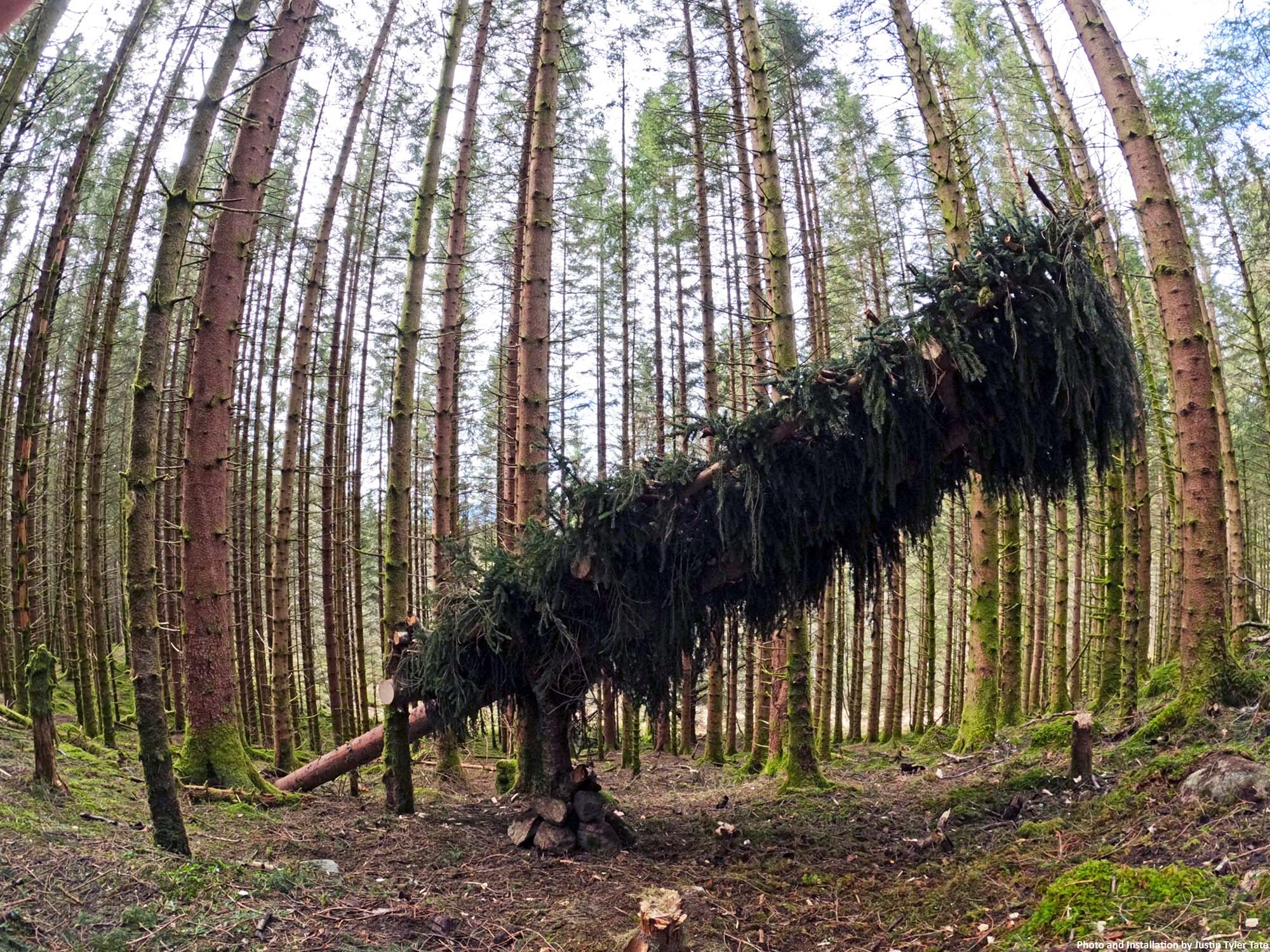
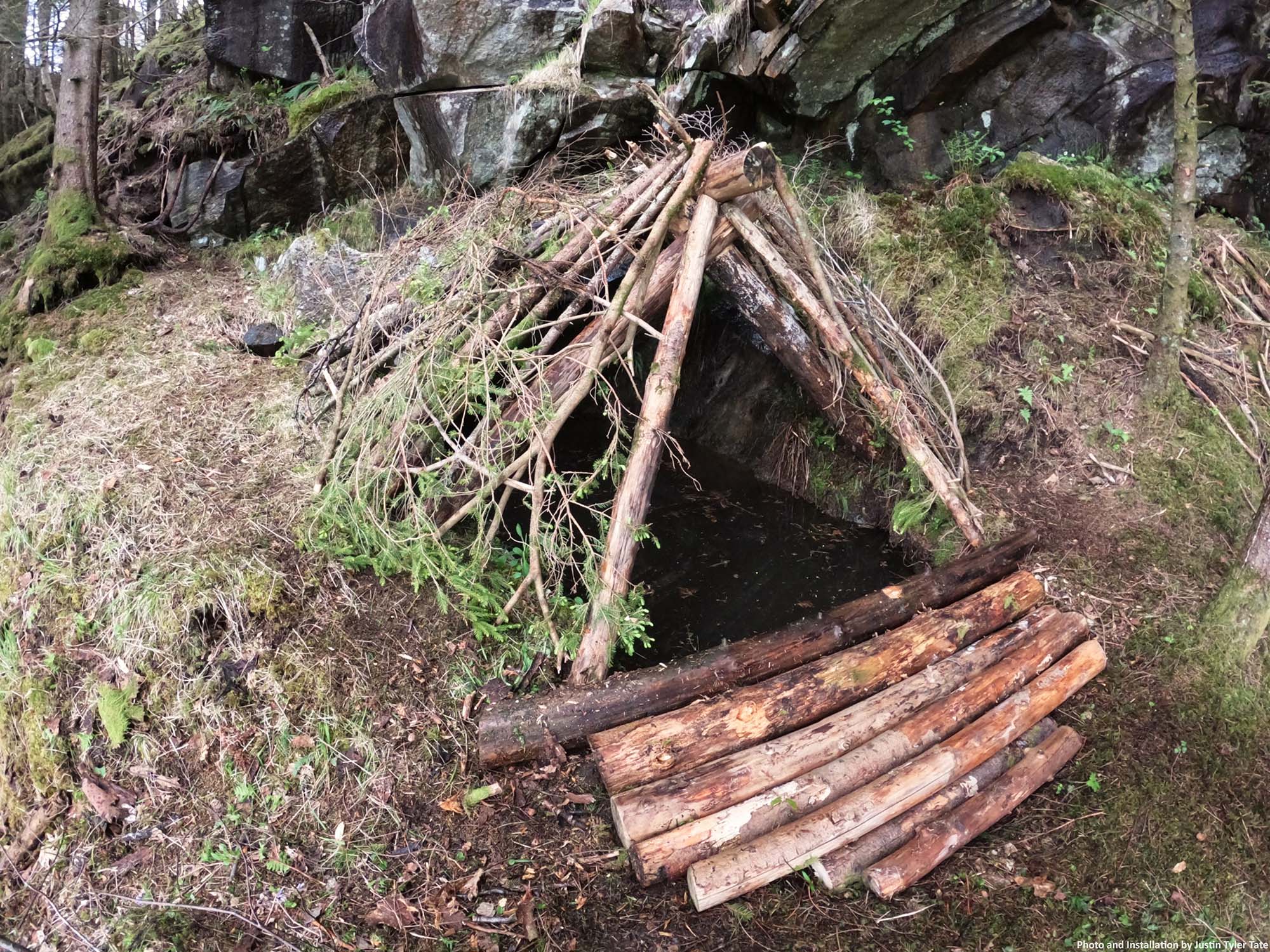
He completed 20 sketches in all, each in some way mimicking, concentrating or intensifying the natural processes on which the local species depend. One collected rainwater and snowmelt into a stone basin for any and all to drink. Another made use of a snagged spruce tree to concentrate moisture on the ground beneath, keeping it shady and damp for fungi. A thatched structure of deadwood and branches sheltered a small pond to prevent the buildup of organic debris, thus keeping the water oxygenated for tadpoles. An inverted teepee did the opposite, gathering fallen debris so as to centralize bacterial decomposition, forming a kind of prolonged composter.
As Tate worked, several unifying themes of post-Anthropocene architecture began to take shape. First, growth and decay have to be incorporated into each design, allowing structures to mature in step with the surrounding ecosystem. (An example is his inverted teepee, which will eventually become a rich mound of soil.) Second, structures must be built of natural materials, with an emphasis on what can be scavenged or reclaimed. (His sketches were built of materials found within 50 metres of each site.) Finally, construction has to be undertaken with the needs of other species in mind – a delicate dance of being human without thinking like one. Such structures should serve nature, and encourage the human animal to empathize with something other than itself.
“The purpose of post-Anthropocene architecture is specifically to develop a non-anthropocentric [non-human-centred] viewpoint,” Tate says. “It’s about developing a process of continuous and active stewardship of the environment, rather than just the utilization of it.”
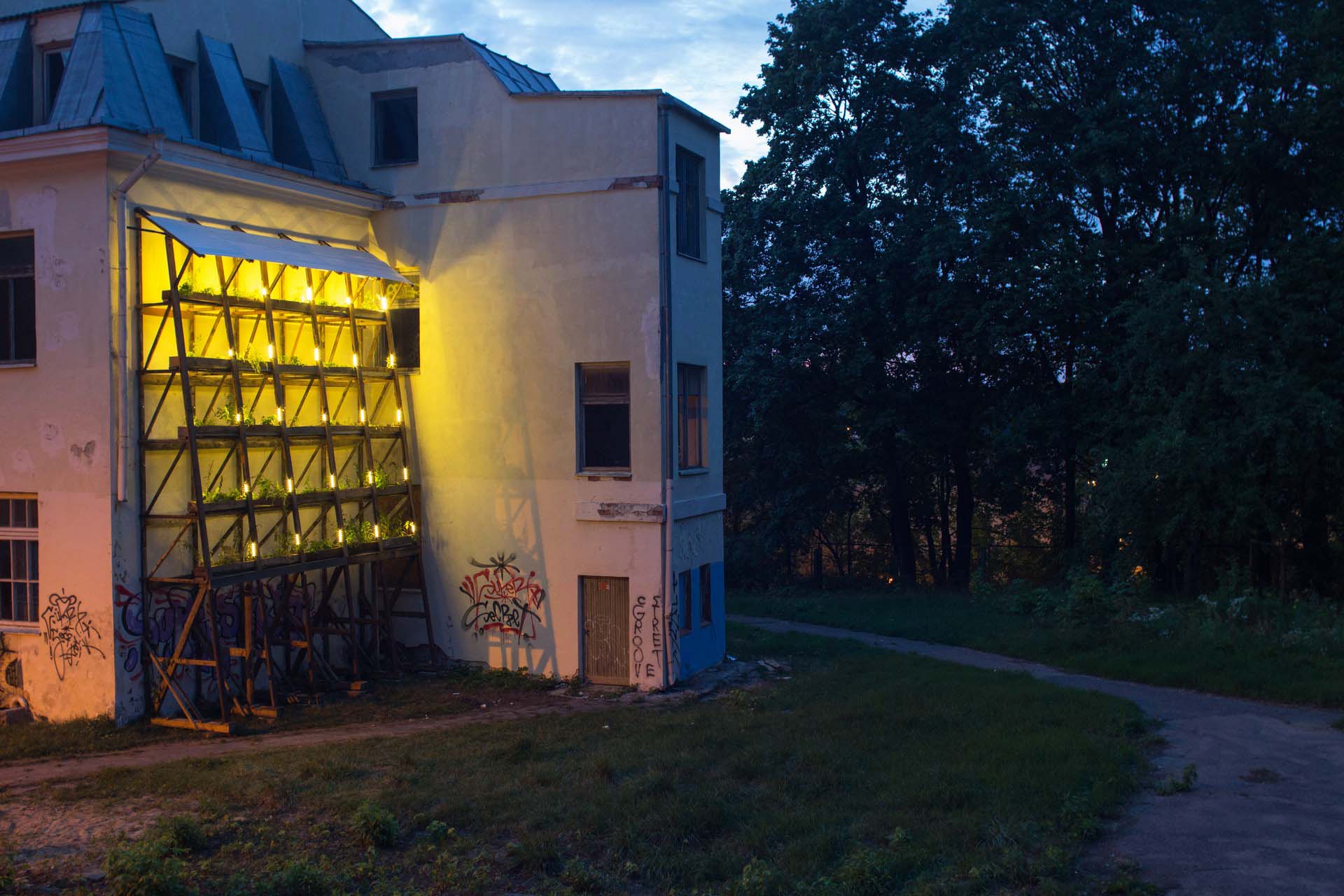
The COVID-19 pandemic has wreaked havoc with his schedule of projects, forcing the postponement of some and outright cancellation of others, such that, to date, he hasn’t yet brought post-Anthropocene architecture to Canada. He hopes to do so sometime in the next year, should the opportunity arise. Exactly what that project will be, and the message it will convey, depends very much on the people who see it.
“I always have my own concept for each work, but I don’t expect a viewer’s ideas or interpretations of it to align with mine,” he says. “I feel that a more achievable goal is to inspire and empower others by allowing my curiosity and tenacity to drive my practice. I make big or complicated things, often by myself in a short period of time, using mostly repurposed and sustainable materials, and usually with a small amount of money. And I feel like that process is empowering, because if I can do it, then why can’t anyone else?”

This article is part of a series on rewilding and the arts as part of the David Suzuki Foundation's inaugural Rewilding Arts Prize. Read more about the prize and the winners here:
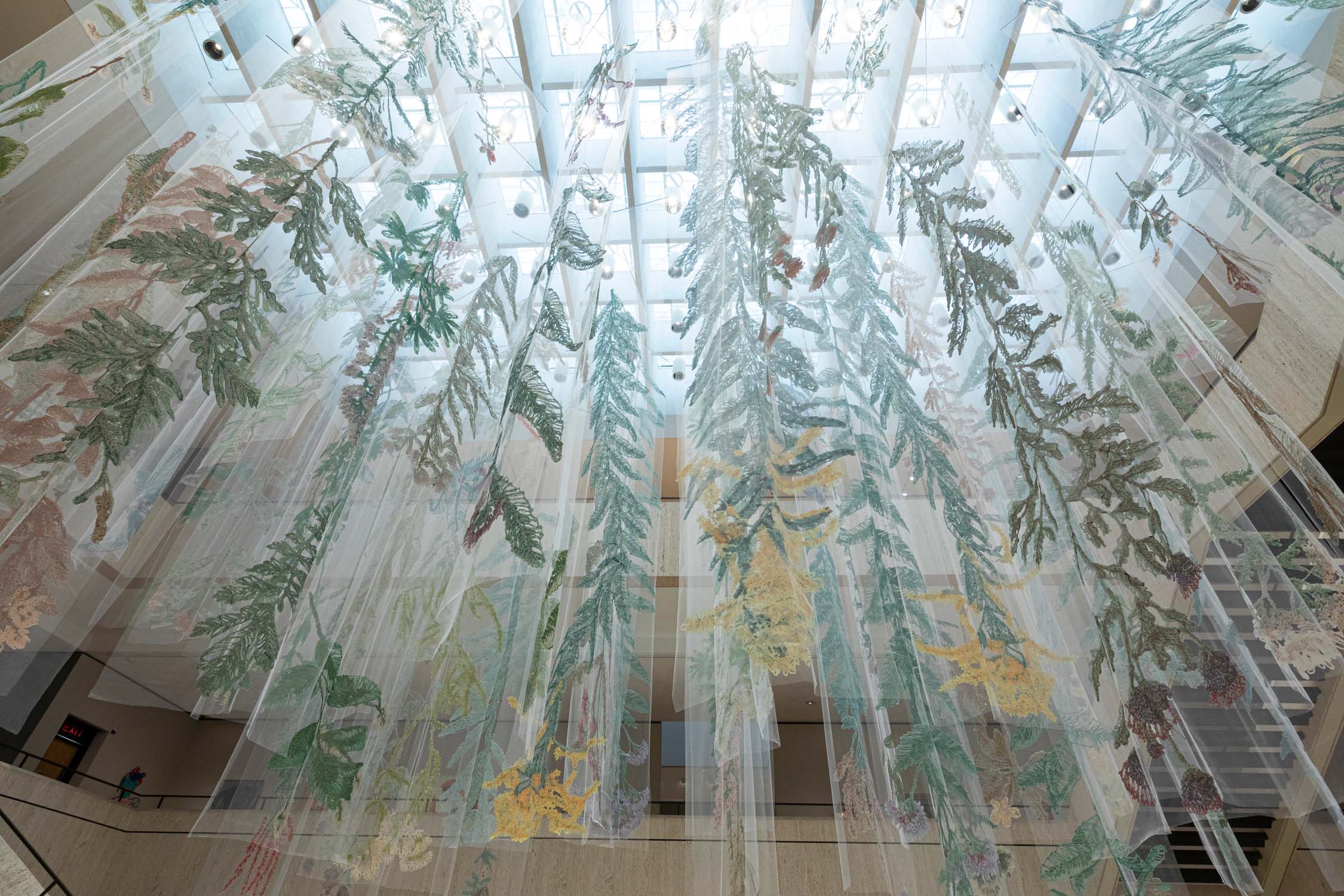





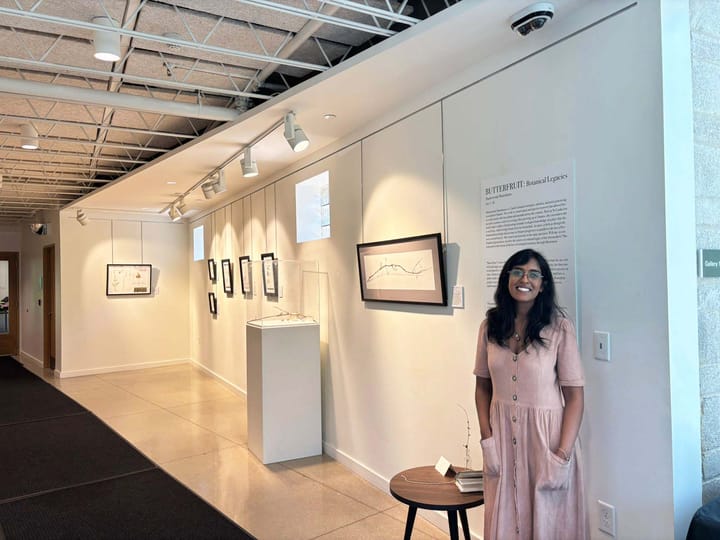
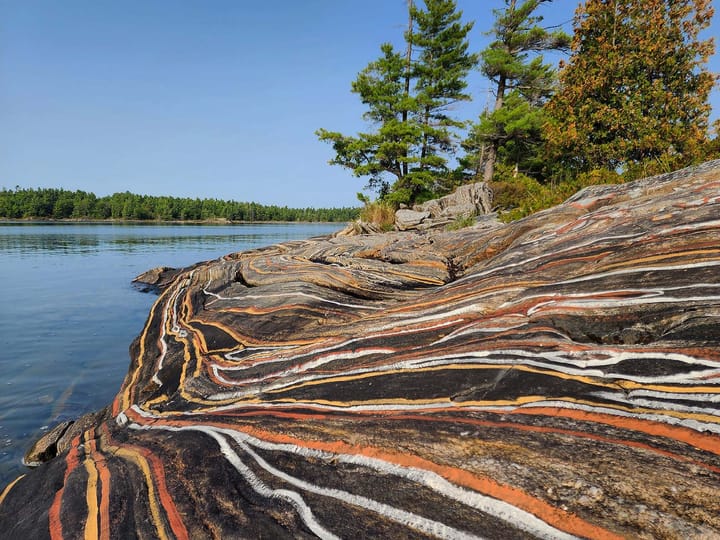



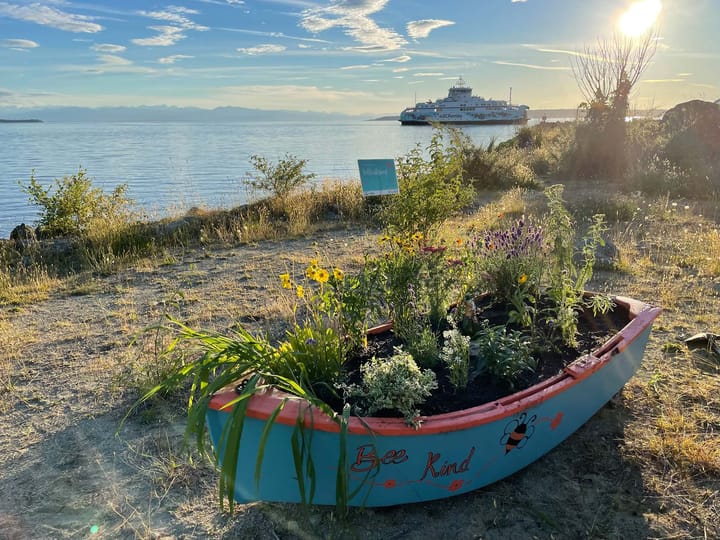


Comments ()